Home » Oil and Gas » North Carolina Natural Gas
Unconventional Natural Gas from Organic Shales in North Carolina?
New drilling methods may open previously unproductive rock units.
Article by: Hobart M. King, PhD

Map of North Carolina's Natural Gas Basins: Map showing generalized locations of the Triassic basins of North Carolina. These hold sedimentary rocks sequences with organic shales that may be suitable for unconventional natural gas production (after Reid & Milici, 2008). Basemap by Geology.com and MapResources.
Is North Carolina the Next Natural Gas Play?
Although North Carolina has no current oil and gas production, drilling methods developed in other states might be used to tap natural gas reservoirs beneath several North Carolina counties.
The Unconventional Shales Gas Rush
New methods of natural gas production are turning previously unproductive rock units across the United States into some of the largest natural gas reservoirs in North America. The Barnett Shale of Texas, the Marcellus Shale of the northeast, and the Haynesville Shale of Louisiana all went from relatively unproductive rock units to reservoirs hosting wells capable of yielding several million cubic feet of gas per day.
Natural gas companies paid landowners above these reservoirs thousands of dollars per acre for temporary drilling rights. If gas was produced from their property they also received royalty payments - which often have been thousands of dollars per year per acre for as long as the well was productive.
These successful gas plays have a few things in common: they are developed in deeply-buried, organic, low-permeability shales that were once marginal producers or unproductive. Today these shales are producing abundant quantities of natural gas through horizontal drilling and hydraulic fracturing.
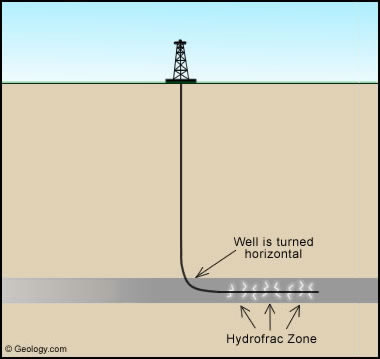
Horizontal gas well: Generalized diagram illustrating a horizontal well with a hydrofracture zone.
Horizontal Wells and Fractured Reservoirs
Normal wells are drilled vertically down through the reservoir rock unit. If the reservoir is 100 feet thick, then the well has a "pay zone" of 100 feet. However, if the well is drilled straight down, turned horizontal within the rock unit and drilled several thousand feet horizontally, then the well has a pay zone of several thousand feet (see diagram). In other parts of the United States this drilling method is turning low-yield rock units into attractive reservoirs.
|
A well enhancement technique known as hydraulic fracturing is also being used in other states. It increases the permeability of the reservoir rock. After a horizontal well is drilled, water is pumped down the well to produce a very high pressure within the reservoir rock unit. This high pressure can fracture the rock, producing a fracture network to drain natural gas from a large volume of rock and allow it to seep into the well.
Organic Shale In North Carolina
Rock units in the Dan River Basin and Deep River Basin of central North Carolina are potential candidates for the drilling methods used in other states (see location map at right). Each of these basins contains a sequence of sedimentary rock several thousand feet thick. The potential natural gas reservoirs in these basins are gray and black organic shales that are thought to represent ancient lake sediments, deposited over 200 million years ago. The Cumnock Formation of the Deep River Basin and the Cow Branch Formation of the Dan River Basin both contain organic-rich shales that might yield commercial quantities of natural gas.
The Gas is Just One Piece of the Puzzle
If these rock units are able to yield abundant quantities of gas, two more things will be needed to make them commercial: 1) nearby customers who are ready to buy a steady flow of gas; and, 2) a gas pipeline system that will collect the gas from the wells and transport it to consumers.
Although natural gas companies are normally the ones who drill wells, Universities, local governments and gas-consuming companies sometimes drill wells on their own property, consume the gas on-site or use it to generate electricity. They spend a few million dollars on the well and have a steady flow of gas that might last for years.
| Information Sources |
|
[1] Natural Gas and Oil in North Carolina: 2009, North Carolina Geological Survey Information Circular 36 - A general interest publication that explains the origin of oil and gas and where they are known to be present in North Carolina. Drilling regulations and permitting details are also covered.
[2] Hydrocarbon Source Rocks in the Deep River and Dan River Triassic Basins, North Carolina: 2008, United States Geological Survey Open File Report 2008-1108 by Jeffrey Reid and Robert Milici; A technical publication that summarizes oil and gas source rock potential of rocks in North Carolina. [3] Tools to evaluate the hydrocarbon potential of the Mesozoic Basins, North Carolina, USA: 2008, Reid, J.C. and Taylor, K.B., American Association of Petroleum Geologists Eastern Section Abstracts with Program. |
Will It Happen in North Carolina?
The new drilling methods could make North Carolina the newest gas-producing area in the United States. The United States Geological Survey and the North Carolina Geological Survey have done preliminary research that makes these shales look promising (see "Information Sources" box). Now it's up to the gas companies and North Carolina entrepreneurs to investigate.
| More Oil |
 |
The Doorway to Hell |
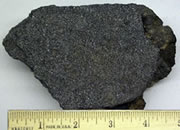 |
Oil Sands |
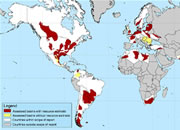 |
Shale Gas Resources |
 |
Gifts That Rock |
 |
Horizontal Drilling |
 |
Oil and Gas Rights |
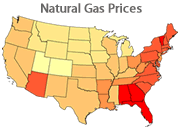 |
Natural Gas Prices |
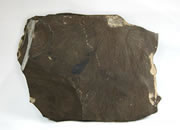 |
Oil Shale |

Find Other Topics on Geology.com:

|

| ||

|

| ||

|

| ||

|

|

